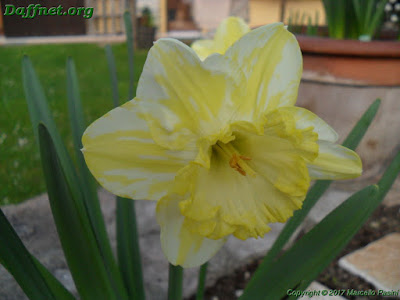Narcissus mosaic virus - A new plumeria virus?
Colour break in reverse bicolour Daffodils
Narcissus mosaic virus (NMV), a specie in the family Potyviridae, is one of the serious viruses for narcissus (daffodils and jonquils). NMV has an extensive range of host plants among narcissus species and beyond the family of Amaryllidaceae such as some species in Amaranthaceae and Aizoaceae. Narcissus is readily infected with NMV by mechanical inoculation. NMV can be transmitted by aphids. Visible viral symptoms of NMV include severe yellowing mosaic, leaf distortion and chlorosis, and flower colour breaking (Fig. 2).
 |
| Figure 2. Colour break in reverse bicolour Daffodil caused by Narcissus mosaic virus (Image credit to Marcello Pasini) |
Narcissus yellow stripe virus (NYSV) is a more common virus for narcissus. Both NYSV and NMV infections are identified as diseases in narcissus propagation and mixed infections appear frequently. The symptoms caused by both NYSV and NMV are very similar and hard to distinguish.
The NMV was reported to cause a colour break in the daffodil, which was linked to a carotenoid‐based change. The virus is associated with the reduction of carotenoid biosynthesis. In reverse bicolour daffodils, upon opening of the flowers, the yellow colour of the perianth is observed to be broken into patches of white (Fig. 2).
The NMV was reported to cause a colour break in the daffodil, which was linked to a carotenoid‐based change. The virus is associated with the reduction of carotenoid biosynthesis. In reverse bicolour daffodils, upon opening of the flowers, the yellow colour of the perianth is observed to be broken into patches of white (Fig. 2).
Colour break in reverse bicolour plumeria
In plumeria, Frangipani mosaic virus (FrMV) associated with the increase of anthocyanin biosynthesis has been well documented whereas Narcissus mosaic virus associated with the reduction of carotenoid biosynthesis has never been reported.
Around the year 2010, I spotted an unusual yellow coloration of a Yellow Bird plumeria's flowers (aka Thornton's Lemon Drop) in a Thai plant market. Instead of the solid yellow flowers (Fig. 5), the yellow colour of its petals was observed to be broken into patches of white (Fig. 4). In 2012, I came across several reports on the daffodils with similar broken coloration caused by the infection of Narcissus mosaic virus. With the similarity in broken coloration on these two yellow flowers, NMV and NYSV become a prime suspect to be responsible for the viral symptom in Thornton's Lemon Drop plumeria. In this case, the color break in plumeria flowers is characterized by the presence of irregular white patches where normally yellow pigments would have been present (Figs. 1 and 4). Nowadays, Thornton's Lemon Drop plumeria with the colour break in reverse bicolour has been reported in Australia, EU and the US.
Virus Photo: https://www.cfgphoto.com/photo-33812.htm
Mosaic virus:
https://www.researchgate.net/publication/237550409_The_cause_of_color_break_in_reverse_bicolor_daffodils
The cause of color break in reverse bicolor daffodils:
https://dafflibrary.org/wp-content/uploads/Hunter-et-al-Cause-of-colour-break-in-daffodils-Report-No.-1800-ADS-sponsored-research.pdf
The cause of color break in reverse bicolor daffodils:
https://dafflibrary.org/wp-content/uploads/Hunter-et-al-Cause-of-colour-break-in-daffodils-Report-No.-1800-ADS-sponsored-research.pdf
Note on Plant Pigments:
Carotenoids are pigments (categorized into two classes i.e. carotenes (orange pigments) and xanthophylls (yellow pigments) responsible for the petal (including leaf and fruit) colors ranging from yellow to orange and bright red.
Flavonoids are pigments (such as chalcones, flavanones, flavones, flavanonols, flavonols, flavanols, and anthocyanins) contributing to a wide spectrum of petal colors, from pale yellow to orange, red, blue, purple, and magenta.
Flavonoids are pigments (such as chalcones, flavanones, flavones, flavanonols, flavonols, flavanols, and anthocyanins) contributing to a wide spectrum of petal colors, from pale yellow to orange, red, blue, purple, and magenta.
Anthocyanins are the largest group of pigments among flavonoids. They are water soluble pigments which impart diverse colors in flowers and fruits or leaves based on their pH conditions. The colors may range from orange to red and from purple to blue. Anthocyanins also provide red colors of many autumn leaves. They may serve to protect photosynthetic tissues from oxidation stress induced by light under stressful conditions.



